check engine SKODA YETI 2012 1.G / 5L User Guide
[x] Cancel search | Manufacturer: SKODA, Model Year: 2012, Model line: YETI, Model: SKODA YETI 2012 1.G / 5LPages: 225, PDF Size: 5.47 MB
Page 106 of 225
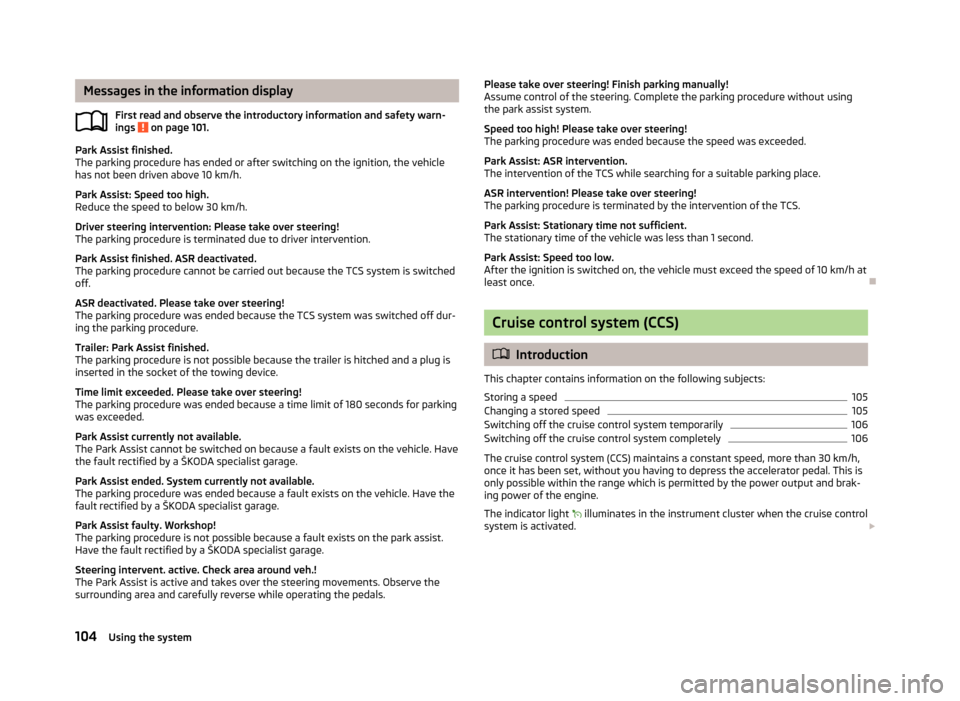
Messages in the information display
First read and observe the introductory information and safety warn-
ings on page 101.
Park Assist finished.
The parking procedure has ended or after switching on the ignition, the vehicle
has not been driven above 10 km/h.
Park Assist: Speed too high.
Reduce the speed to below 30 km/h.
Driver steering intervention: Please take over steering!
The parking procedure is terminated due to driver intervention.
Park Assist finished. ASR deactivated.
The parking procedure cannot be carried out because the TCS system is switched
off.
ASR deactivated. Please take over steering!
The parking procedure was ended because the TCS system was switched off dur-
ing the parking procedure.
Trailer: Park Assist finished.
The parking procedure is not possible because the trailer is hitched and a plug is
inserted in the socket of the towing device.
Time limit exceeded. Please take over steering!
The parking procedure was ended because a time limit of 180 seconds for parking
was exceeded.
Park Assist currently not available.
The Park Assist cannot be switched on because a fault exists on the vehicle. Have
the fault rectified by a ŠKODA specialist garage.
Park Assist ended. System currently not available.
The parking procedure was ended because a fault exists on the vehicle. Have the
fault rectified by a ŠKODA specialist garage.
Park Assist faulty. Workshop!
The parking procedure is not possible because a fault exists on the park assist.
Have the fault rectified by a ŠKODA specialist garage.
Steering intervent. active. Check area around veh.!
The Park Assist is active and takes over the steering movements. Observe the
surrounding area and carefully reverse while operating the pedals. ä
Please take over steering! Finish parking manually!
Assume control of the steering. Complete the parking procedure without using
the park assist system.
Speed too high! Please take over steering!
The parking procedure was ended because the speed was exceeded.
Park Assist: ASR intervention.
The intervention of the TCS while searching for a suitable parking place.
ASR intervention! Please take over steering!
The parking procedure is terminated by the intervention of the TCS.
Park Assist: Stationary time not sufficient.
The stationary time of the vehicle was less than 1 second.
Park Assist: Speed too low.
After the ignition is switched on, the vehicle must exceed the speed of 10 km/h at
least once. Ð Cruise control system (CCS)
ä
Introduction
This chapter contains information on the following subjects:
Storing a speed 105
Changing a stored speed 105
Switching off the cruise control system temporarily 106
Switching off the cruise control system completely 106
The cruise control system (CCS) maintains a constant speed, more than 30 km/h,
once it has been set, without you having to depress the accelerator pedal. This is
only possible within the range which is permitted by the power output and brak-
ing power of the engine.
The indicator light illuminates in the instrument cluster when the cruise control
system is activated. £
104 Using the system
Page 108 of 225
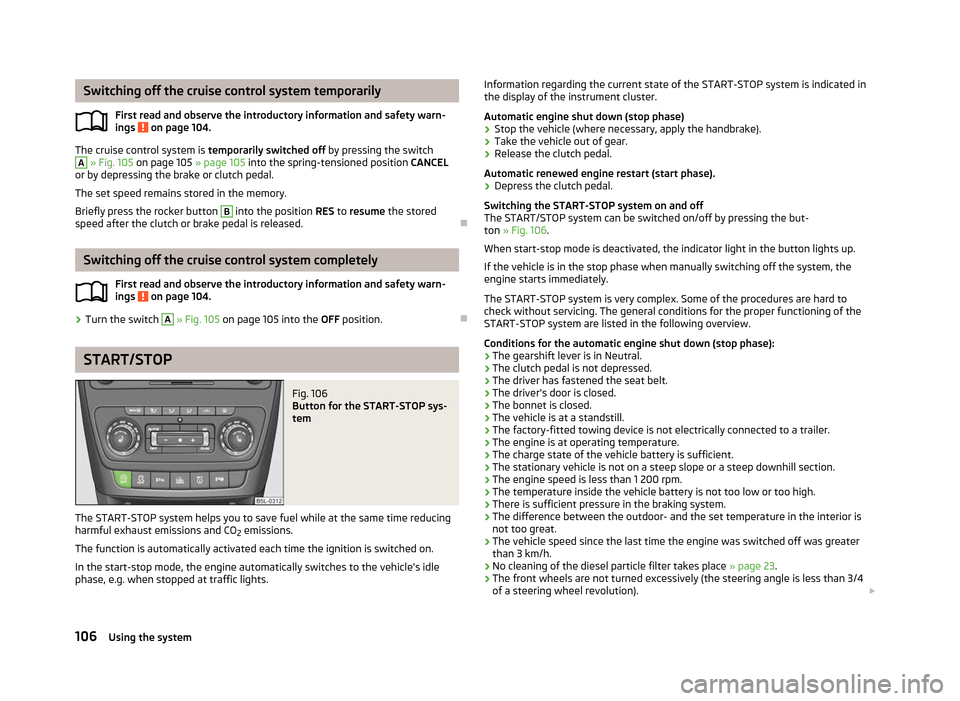
Switching off the cruise control system temporarily
First read and observe the introductory information and safety warn-
ings on page 104.
The cruise control system is
temporarily switched off by pressing the switchA
» Fig. 105 on page 105 » page 105
into the spring-tensioned position CANCEL
or by depressing the brake or clutch pedal.
The set speed remains stored in the memory.
Briefly press the rocker button B
into the position RES
to resume the stored
speed after the clutch or brake pedal is released. ÐSwitching off the cruise control system completely
First read and observe the introductory information and safety warn-
ings on page 104.
›
Turn the switch A
» Fig. 105 on page 105 into the OFF position.
ÐSTART/STOP
Fig. 106
Button for the START-STOP sys-
tem
The START-STOP system helps you to save fuel while at the same time reducing
harmful exhaust emissions and CO 2 emissions.
The function is automatically activated each time the ignition is switched on.
In the start-stop mode, the engine automatically switches to the vehicle's idle
phase, e.g. when stopped at traffic lights.
ä
ä Information regarding the current state of the START-STOP system is indicated in
the display of the instrument cluster.
Automatic engine shut down (stop phase)
› Stop the vehicle (where necessary, apply the handbrake).
› Take the vehicle out of gear.
› Release the clutch pedal.
Automatic renewed engine restart (start phase).
› Depress the clutch pedal.
Switching the
START-STOP system on and off
The START/STOP system can be switched on/off by pressing the but-
ton » Fig. 106.
When start-stop mode is deactivated, the indicator light in the button lights up.
If the vehicle is in the stop phase when manually switching off the system, the
engine starts immediately.
The START-STOP system is very complex. Some of the procedures are hard to
check without servicing. The general conditions for the proper functioning of the
START-STOP system are listed in the following overview.
Conditions for the automatic engine shut down (stop phase):
› The gearshift lever is in Neutral.
› The clutch pedal is not depressed.
› The driver has fastened the seat belt.
› The driver's door is closed.
› The bonnet is closed.
› The vehicle is at a standstill.
› The factory-fitted towing device is not electrically connected to a trailer.
› The engine is at operating temperature.
› The charge state of the vehicle battery is sufficient.
› The stationary vehicle is not on a steep slope or a steep downhill section.
› The engine speed is less than 1 200 rpm.
› The temperature inside the vehicle battery is not too low or too high.
› There is sufficient pressure in the braking system.
› The difference between the outdoor- and the set temperature in the interior is
not too great.
› The vehicle speed since the last time the engine was switched off was greater
than 3 km/h.
› No cleaning of the diesel particle filter takes place
» page 23.
› The front wheels are not turned excessively (the steering angle is less than 3/4
of a steering wheel revolution).
£
106 Using the system
Page 148 of 225
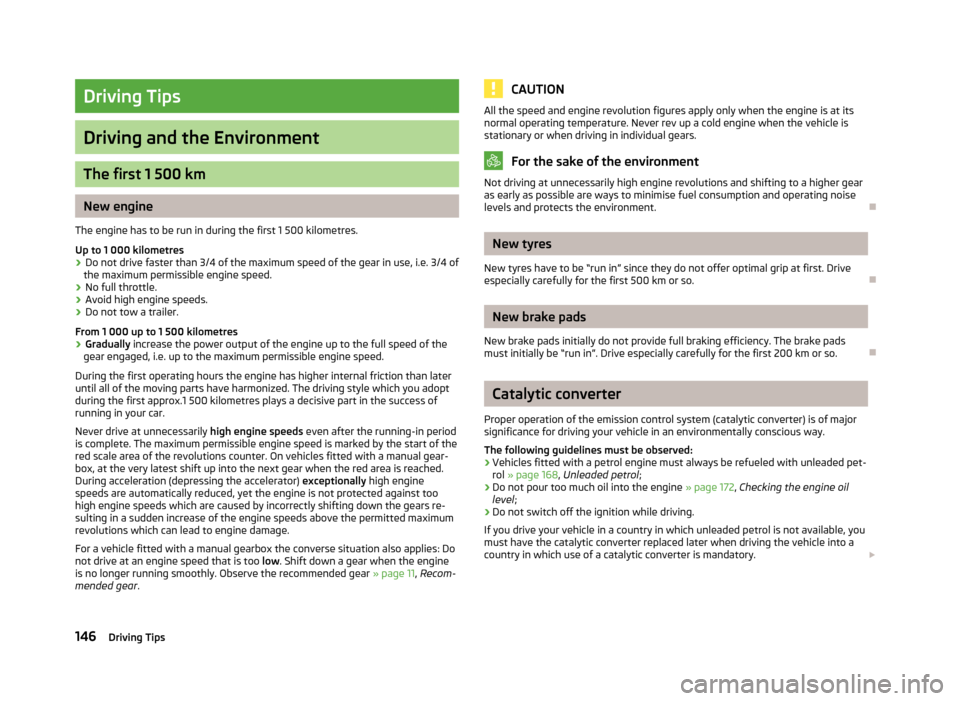
Driving Tips
Driving and the Environment
The first 1 500 km
New engine
The engine has to be run in during the first 1 500 kilometres.
Up to 1 000 kilometres › Do not drive faster than 3/4 of the maximum speed of the gear in use, i.e. 3/4 of
the maximum permissible engine speed.
› No full throttle.
› Avoid high engine speeds.
› Do not tow a trailer.
From 1 000 up to 1
500 kilometres
› Gradually
increase the power output of the engine up to the full speed of the
gear engaged, i.e. up to the maximum permissible engine speed.
During the first operating hours the engine has higher internal friction than later
until all of the moving parts have harmonized. The driving style which you adopt
during the first approx.1
500 kilometres plays a decisive part in the success of
running in your car.
Never drive at unnecessarily high engine speeds even after the running-in period
is complete. The maximum permissible engine speed is marked by the start of the
red scale area of the revolutions counter. On vehicles fitted with a manual gear-
box, at the very latest shift up into the next gear when the red area is reached.
During acceleration (depressing the accelerator) exceptionally high engine
speeds are automatically reduced, yet the engine is not protected against too
high engine speeds which are caused by incorrectly shifting down the gears re-
sulting in a sudden increase of the engine speeds above the permitted maximum
revolutions which can lead to engine damage.
For a vehicle fitted with a manual gearbox the converse situation also applies: Do
not drive at an engine speed that is too low. Shift down a gear when the engine
is no longer running smoothly. Observe the recommended gear » page 11, Recom-
mended gear . CAUTION
All the speed and engine revolution figures apply only when the engine is at its
normal operating temperature. Never rev up a cold engine when the vehicle is
stationary or when driving in individual gears. For the sake of the environment
Not driving at unnecessarily high engine revolutions and shifting to a higher gear
as early as possible are ways to minimise fuel consumption and operating noise
levels and protects the environment. Ð New tyres
New tyres have to be “
run in” since they do not offer optimal grip at first. Drive
especially carefully for the first 500 km or so. Ð New brake pads
New brake pads initially do not provide full braking efficiency. The brake pads
must initially be “run in
”. Drive especially carefully for the first 200 km or so. Ð Catalytic converter
Proper operation of the emission control system (catalytic converter) is of major
significance for driving your vehicle in an environmentally conscious way.
The following guidelines must be observed: › Vehicles fitted with a petrol engine must always be refueled with unleaded pet-
rol » page 168 , Unleaded petrol ;
› Do not pour too much oil into the engine
» page 172, Checking the engine oil
level ;
› Do not switch off the ignition while driving.
If you drive your vehicle in a country in which unleaded petrol is not available, you
must have the catalytic converter replaced later when driving the vehicle into a
country in which use of a catalytic converter is mandatory. £
146 Driving Tips
Page 150 of 225
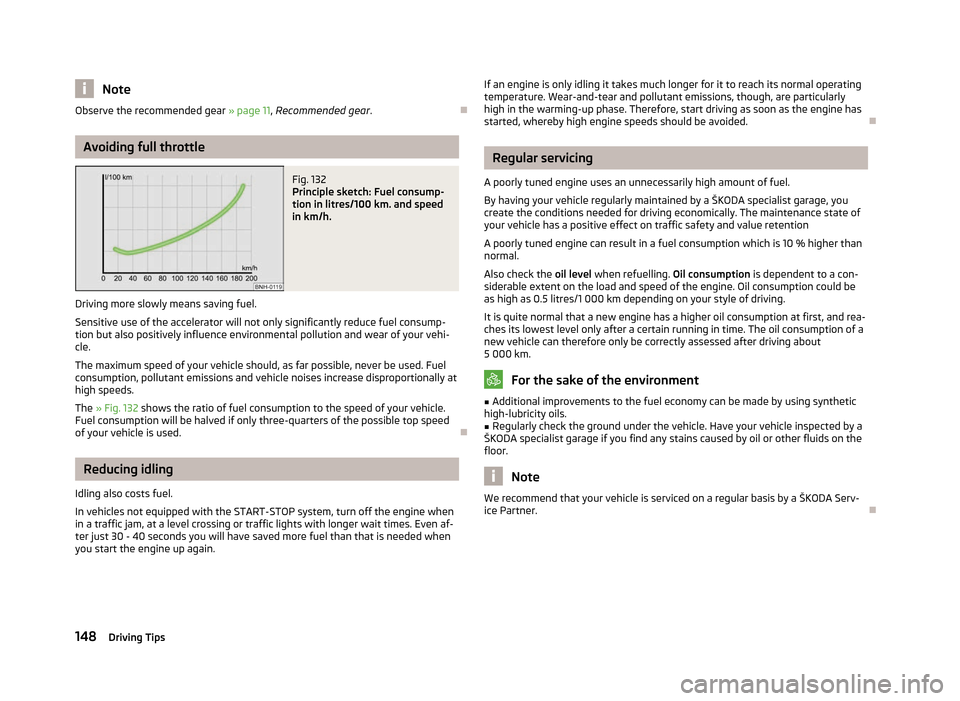
Note
Observe the recommended gear » page 11, Recommended gear .ÐAvoiding full throttle
Fig. 132
Principle sketch: Fuel consump-
tion in litres/100 km. and speed
in km/h.
Driving more slowly means saving fuel.
Sensitive use of the accelerator will not only significantly reduce fuel consump-
tion but also positively influence environmental pollution and wear of your vehi-
cle.
The maximum speed of your vehicle should, as far possible, never be used. Fuel
consumption, pollutant emissions and vehicle noises increase disproportionally at
high speeds.
The » Fig. 132 shows the ratio of fuel consumption to the speed of your vehicle.
Fuel consumption will be halved if only three-quarters of the possible top speed
of your vehicle is used. ÐReducing idling
Idling also costs fuel.
In vehicles not equipped with the
START-STOP system, turn off the engine when
in a traffic jam, at a level crossing or traffic lights with longer wait times. Even af-
ter just 30 - 40 seconds you will have saved more fuel than that is needed when
you start the engine up again. If an engine is only idling it takes much longer for it to reach its normal operating
temperature. Wear-and-tear and pollutant emissions, though, are particularly
high in the warming-up phase. Therefore, start driving as soon as the engine has
started, whereby high engine speeds should be avoided. Ð Regular servicing
A poorly tuned engine uses an unnecessarily high amount of fuel.
By having your vehicle regularly maintained by a ŠKODA
specialist garage, you
create the conditions needed for driving economically. The maintenance state of
your vehicle has a positive effect on traffic safety and value retention
A poorly tuned engine can result in a fuel consumption which is 10 % higher than
normal.
Also check the oil level when refuelling. Oil consumption is dependent to a con-
siderable extent on the load and speed of the engine. Oil consumption could be
as high as 0.5 litres/1 000 km depending on your style of driving.
It is quite normal that a new engine has a higher oil consumption at first, and rea-
ches its lowest level only after a certain running in time. The oil consumption of a
new vehicle can therefore only be correctly assessed after driving about
5 000 km. For the sake of the environment
■ Additional improvements to the fuel economy can be made by using synthetic
high-lubricity oils.
■ Regularly check the ground under the vehicle. Have your vehicle inspected by a
ŠKODA specialist garage if you find any stains caused by oil or other fluids on the
floor. Note
We recommend that your vehicle is serviced on a regular basis by a ŠKODA Serv-
ice Partner. Ð
148 Driving Tips
Page 151 of 225

Avoid short distances
Fig. 133
Principle sketch: Fuel consump-
tion in l/100 km at different tem-
peratures
Short distances result in an above-average high fuel consumption. We therefore
recommend avoiding distances of less than 4 km if the engine is cold.
A cold engine consumes the most fuel immediately after the start. Fuel consump-
tion drops to 10 litres/100 km after just 1 kilometre. The consumption stabilises
once the engine and catalytic converter have reached their operating tempera-
ture.
An important factor in this connection is also the ambient temperature. The im-
age » Fig. 133 shows the different levels of fuel consumption after driving a cer-
tain distance at a temperature of +20 °C and a temperature of -10 °C. Your vehicle
has a higher fuel consumption in the winter than in the summer. ÐChecking tyre inflation pressures
Tyres which are correctly inflated save fuel.
Always ensure the tyre inflation pressure is correct. The rolling resistance will be
increased if the tyre filling pressure is too low. This will not only increase fuel con-
sumption but also tyre wear and the driving behaviour will worsen.
Always check the tyre inflation pressure when the tyres are cold. ÐAvoid unnecessary ballast
Transporting ballast costs fuel.
Each kilogramme of weight increases the fuel consumption. It is worth checking
the boot to avoid transporting any unnecessary ballast. It is particularly in town traffic, when one is accelerating quite often, that the ve-
hicle weight will have a significant effect upon the fuel consumption. A rule of
thumb here is that an increase in weight of 100 kilograms will cause an increase
in fuel consumption of about 1 litre/100 kilometres.
At a speed of 100 - 120 km/h, your vehicle that is fitted with a roof rack cross
member without a load will use use about 10 % more fuel than normal due to the
increased aerodynamic drag.
Ð Saving electricity
When the engine is running, the alternator generates and supplies electrical pow-
er. If more electrical components of the electrical system are switched on, more
fuel is needed to operate the alternator. We therefore recommend switching off
electrical components if these are no longer required. Ð Environmental compatibility
Environmental protection has played a major role in the design, selection of mate-
rials and manufacture of your new
ŠKODA. Particular emphasis has been placed
on the following points:
Design measures
› Joints designed to be easily detached.
› Simplified disassembly due to the modular structure system.
› Improved purity of different classes of materials.
› Identification of all plastic parts in accordance with VDA Recommendation 260.
› Reduced fuel consumption and exhaust emission CO
2.
› Minimum fuel leakage during accidents.
› Reduced noise.
Choice of materials › Extensive use of recyclable material.
› Air conditioning filled with CFC-free refrigerant.
› No cadmium.
› No asbestos.
› Reduction in the “vaporisation” of plastics.
Manufacture › Solvent-free cavity protection.
› Solvent-free protection of the vehicle for transportation from the production
plant to the customer. £
149
Driving and the Environment
Page 153 of 225

Driving through water on the street
Fig. 134
Driving through water
The following must be observed to avoid damage to the vehicle when driving
through bodies of water (e.g. flooded roads): › Therefore determine the depth of the water before driving through bodies of
water. The water level must fit around the strut on the side member as a maxi-
mum » Fig. 134;
› Do not drive any faster than at a walking speed. At a higher speed, a water
wave can form in front of the vehicle which can cause water to penetrate into
the air induction system of the engine or into other parts of the vehicle;
› Never stop in the water, do not reverse and do not switch the engine off;
› Deactivate the START-STOP
system before driving through water » page 106,
START/STOP . WARNING
■ Driving through water, mud, sludge etc. can reduce the braking power and
extend the braking distance - risk of accident!
■ Avoid abrupt and sudden braking immediately after water crossings.
■ After driving through bodies of water, the brakes must be cleaned and dried
as soon as possible by intermittent braking. Only apply the brakes for the pur-
pose of drying and cleaning the brake discs if the traffic conditions permit this.
Do not place any other road users in jeopardy. CAUTION
■ When driving through bodies of water, parts of the vehicle such as the engine,
gearbox, chassis or electrics can be severely damaged.
■ Oncoming vehicles can generate water waves which can exceed the permissible
water level for your vehicle. ■
Potholes, mud or rocks can be hidden under the water making it difficult or im-
possible to drive through the body of water. ■ Do not drive through salt water. The salt can lead to corrosion. Any vehicle parts
that have come into contact with salt water must be rinsed immediately with
fresh water. Note
After driving through a body of water, we recommend that the vehicle is checked
by a
ŠKODA specialist garage. Ð Off-road driving
ä
Introduction
This chapter contains information on the following subjects:
Explanation of technical terms 152
Before driving off-road 153
Off-road driving 154
Changing gear when driving off-road 154
Driving at an angle on a hillside 155
Stuck vehicle 155
After driving off-road 156
We cannot discuss all the possible driving situations in this manual, because
there are so many types of terrains which may hide different risks and dangers.
The examples listed in this manual are general rules for safe off-road driving. It is
however not possible to predict if these rules are valid for all the situations which
may occur. Before driving through unknown terrain, it is therefore important that
you know what lies ahead of you. This way you can estimate any possible danger
in advance.
When driving off-road, pay attention to the national legal regulations. £
151
Driving and the Environment
Page 154 of 225

WARNING
■ Be very alert and look ahead when driving off-road. Always adjust your driv-
ing to the current of-road, traffic and weather conditions. Excessive speed or
incorrect driving manoeuvres can cause damage to the vehicle and lead to se-
rious injuries.
■ The Assistance systems of your vehicle cannot overcome the physical limits
of your vehicle.
■ Do not drive over embankments, ramps or hillsides at too high a speed. This
can lead to the wheels of the vehicle lifting off the ground so that you can no
longer steer and control the vehicle.
■ If the wheels lose contact with the ground, for example when the vehicle re-
bounds while driving over corrugations, steer straight ahead. If the wheels are
turned when making the contact with the ground again, the vehicle can roll
over.
■ There should never be any person in front or behind the vehicle when rocks,
scrub, wood pieces or other objects are placed under the wheels in order to
achieve traction on a sandy or slippery ground. Turning the wheels can trans-
form these objects into dangerous
“bullets” – risk of death!
■ Luggage and other items, which are transported on the roof of the vehicle,
additionally raise the centre of gravity and thus increase the risk of a rollover. ■ Never attempt to drive uphill or downhill if it is too steep for your vehicle.
The vehicle could slip, tilt or roll over - risk of accident! » table on page 153
■ Never attempt to make a turn on a hillside. The vehicle could tilt or roll over.
This can result in serious accidents.
■ Never let the vehicle roll down the hillside at idling speed. You can lose the
control over your vehicle.
■ If the engine cuts out, stop and restart the engine.
■ Objects trapped under the floor of the vehicle can damage the fuel lines, the
brake system, the seals and other parts of the chassis. Check the underside of
the vehicle and remove the trapped objects. Combustible objects such as dry
leaves or twigs could ignite on hot vehicle parts - risk of fire! CAUTION
■ Pay attention to the ground clearance of the vehicle! When driving over objects
which are larger than the ground clearance, the chassis and its components can
get damaged. ■ Do not leave your foot on the clutch pedal or let the clutch slip when driving off-
road. Overwise you may unintentionally depress the clutch pedal on uneven
ground leading to a loss of control over the vehicle. For the sake of the environment
Pay attention to the environment when driving off-road. Ð Explanation of technical terms
Fig. 135
Embankment angle/slope angle Fig. 136
Ground clearance/ramp angle
First read and observe the introductory information and safety warn-
ings on page 151.
The technical data » table on page 153
refer to ideal conditions. These values
may differ depending on the load and composition of the soil and the environ-
ment. The driver is responsible to decide whether a vehicle can overcome a cer-
tain situation. £
ä
152 Driving Tips
Page 155 of 225
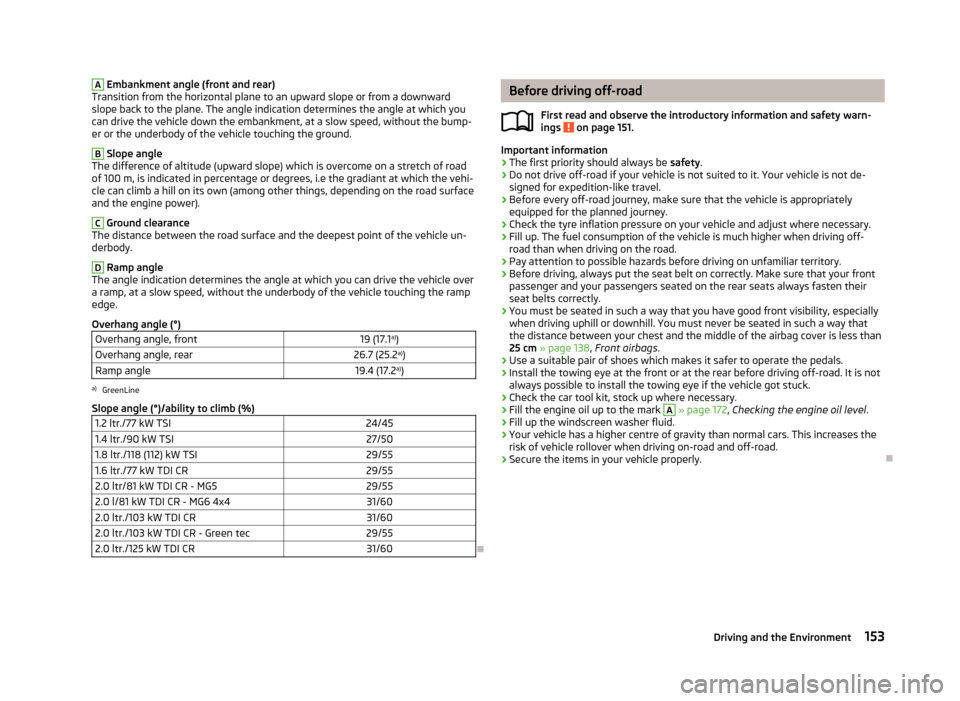
A
Embankment angle (front and rear)
Transition from the horizontal plane to an upward slope or from a downward
slope back to the plane. The angle indication determines the angle at which you
can drive the vehicle down the embankment, at a slow speed, without the bump-
er or the underbody of the vehicle touching the ground. B
Slope angle
The difference of altitude (upward slope) which is overcome on a stretch of road
of 100 m, is indicated in percentage or degrees, i.e the gradiant at which the vehi-
cle can climb a hill on its own (among other things, depending on the road surface
and the engine power). C
Ground clearance
The distance between the road surface and the deepest point of the vehicle un-
derbody. D
Ramp angle
The angle indication determines the angle at which you can drive the vehicle over
a ramp, at a slow speed, without the underbody of the vehicle touching the ramp
edge.
Overhang angle (°)
Overhang angle, front 19 (17.1a)
)
Overhang angle, rear 26.7 (25.2a)
)
Ramp angle 19.4 (17.2a)
) a)
GreenLine
Slope angle (°)/ability to climb (%) 1.2 ltr./77 kW TSI 24/45
1.4 ltr./90 kW TSI 27/50
1.8 ltr./118 (112) kW TSI 29/55
1.6 ltr./77 kW TDI CR 29/55
2.0 ltr/81 kW TDI CR - MG5 29/55
2.0 l/81 kW TDI CR - MG6 4x4 31/60
2.0 ltr./103 kW TDI CR 31/60
2.0 ltr./103 kW TDI CR - Green tec 29/55
2.0 ltr./125 kW TDI CR 31/60 Ð Before driving off-road
First read and observe the introductory information and safety warn-
ings on page 151.
Important information
› The first priority should always be
safety.
› Do not drive off-road if your vehicle is not suited to it. Your vehicle is not de-
signed for expedition-like travel.
› Before every off-road journey, make sure that the vehicle is appropriately
equipped for the planned journey.
› Check the tyre inflation pressure on your vehicle and adjust where necessary.
› Fill up. The fuel consumption of the vehicle is much higher when driving off-
road than when driving on the road.
› Pay attention to possible hazards before driving on unfamiliar territory.
› Before driving, always put the seat belt on correctly. Make sure that your front
passenger and your passengers seated on the rear seats always fasten their
seat belts correctly.
› You must be seated in such a way that you have good front visibility, especially
when driving uphill or downhill. You must never be seated in such a way that
the distance between your chest and the middle of the airbag cover is less than
25 cm » page 138, Front airbags.
› Use a suitable pair of shoes which makes it safer to operate the pedals.
› Install the towing eye at the front or at the rear before driving off-road. It is not
always possible to install the towing eye if the vehicle got stuck.
› Check the car tool kit, stock up where necessary.
› Fill the engine oil up to the mark A
» page 172
, Checking the engine oil level .
› Fill up the windscreen washer fluid.
› Your vehicle has a higher centre of gravity than normal cars. This increases the
risk of vehicle rollover when driving on-road and off-road.
› Secure the items in your vehicle properly. Ð
ä
153
Driving and the Environment
Page 158 of 225
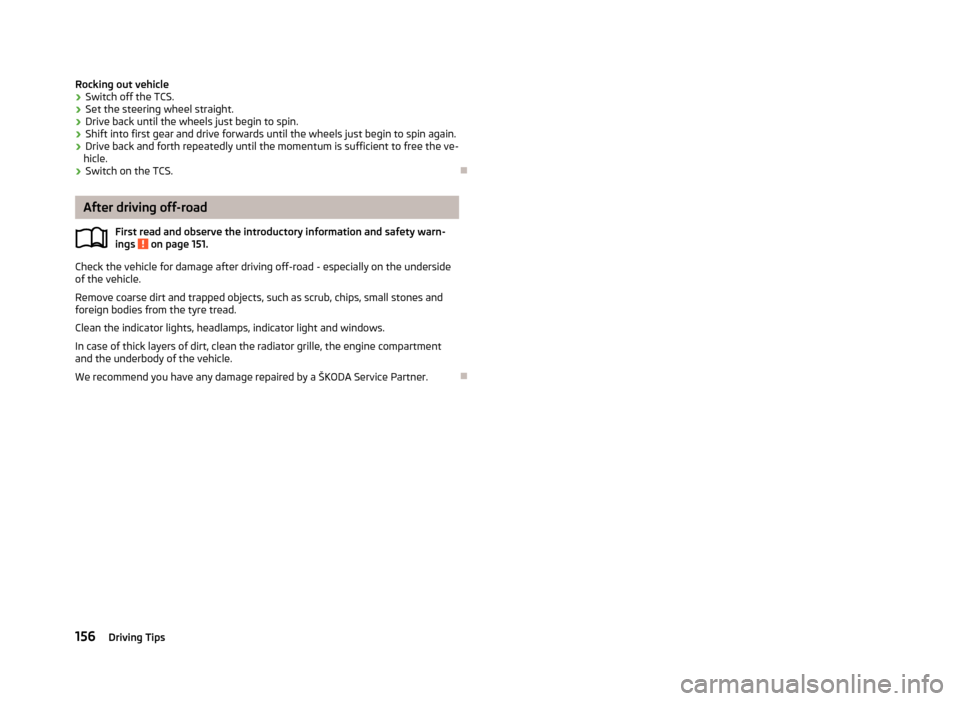
Rocking out vehicle
›
Switch off the TCS.
› Set the steering wheel straight.
› Drive back until the wheels just begin to spin.
› Shift into first gear and drive forwards until the wheels just begin to spin again.
› Drive back and forth repeatedly until the momentum is sufficient to free the ve-
hicle.
› Switch on the TCS. ÐAfter driving off-road
First read and observe the introductory information and safety warn-
ings on page 151.
Check the vehicle for damage after driving off-road - especially on the underside
of the vehicle.
Remove coarse dirt and trapped objects, such as scrub, chips, small stones and
foreign bodies from the tyre tread.
Clean the indicator lights, headlamps, indicator light and windows.
In case of thick layers of dirt, clean the radiator grille, the engine compartment
and the underbody of the vehicle.
We recommend you have any damage repaired by a
ŠKODA Service Partner.Ðä
156 Driving Tips
Page 159 of 225
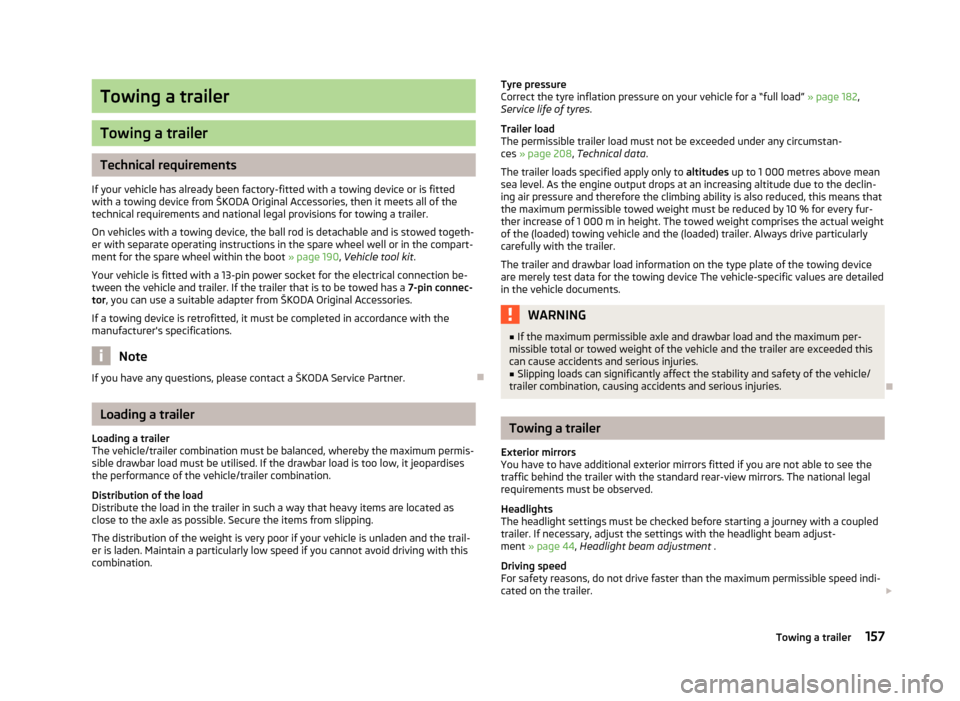
Towing a trailer
Towing a trailer
Technical requirements
If your vehicle has already been factory-fitted with a towing device or is fitted
with a towing device from ŠKODA Original Accessories, then it meets all of the
technical requirements and national legal provisions for towing a trailer.
On vehicles with a towing device, the ball rod is detachable and is stowed togeth-
er with separate operating instructions in the spare wheel well or in the compart-
ment for the spare wheel within the boot » page 190, Vehicle tool kit.
Your vehicle is fitted with a 13-pin power socket for the electrical connection be-
tween the vehicle and trailer. If the trailer that is to be towed has a 7-pin connec-
tor, you can use a suitable adapter from
ŠKODA Original Accessories.
If a towing device is retrofitted, it must be completed in accordance with the
manufacturer's specifications. Note
If you have any questions, please contact a ŠKODA Service Partner. ÐLoading a trailer
Loading a trailer
The vehicle/trailer combination must be balanced, whereby the maximum permis-
sible drawbar load must be utilised. If the drawbar load is too low, it jeopardises
the performance of the vehicle/trailer combination.
Distribution of the load
Distribute the load in the trailer in such a way that heavy items are located as
close to the axle as possible. Secure the items from slipping.
The distribution of the weight is very poor if your vehicle is unladen and the trail-
er is laden. Maintain a particularly low speed if you cannot avoid driving with this
combination. Tyre pressure
Correct the tyre inflation pressure on your vehicle for a
“full load” » page 182 ,
Service life of tyres.
Trailer load
The permissible trailer load must not be exceeded under any circumstan-
ces » page 208 , Technical data .
The trailer loads specified apply only to altitudes up to 1 000 metres above mean
sea level. As the engine output drops at an increasing altitude due to the declin-
ing air pressure and therefore the climbing ability is also reduced, this means that
the maximum permissible towed weight must be reduced by 10 % for every fur-
ther increase of 1 000 m in height. The towed weight comprises the actual weight
of the (loaded) towing vehicle and the (loaded) trailer. Always drive particularly
carefully with the trailer.
The trailer and drawbar load information on the type plate of the towing device
are merely test data for the towing device The vehicle-specific values are detailed
in the vehicle documents. WARNING
■ If the maximum permissible axle and drawbar load and the maximum per-
missible total or towed weight of the vehicle and the trailer are exceeded this
can cause accidents and serious injuries.
■ Slipping loads can significantly affect the stability and safety of the vehicle/
trailer combination, causing accidents and serious injuries. Ð Towing a trailer
Exterior mirrors
You have to have additional exterior mirrors fitted if you are not able to see the
traffic behind the trailer with the standard rear-view mirrors. The national legal
requirements must be observed.
Headlights
The headlight settings must be checked before starting a journey with a coupled
trailer. If necessary, adjust the settings with the headlight beam adjust-
ment » page 44 , Headlight beam adjustment .
Driving speed
For safety reasons, do not drive faster than the maximum permissible speed indi-
cated on the trailer. £
157
Towing a trailer